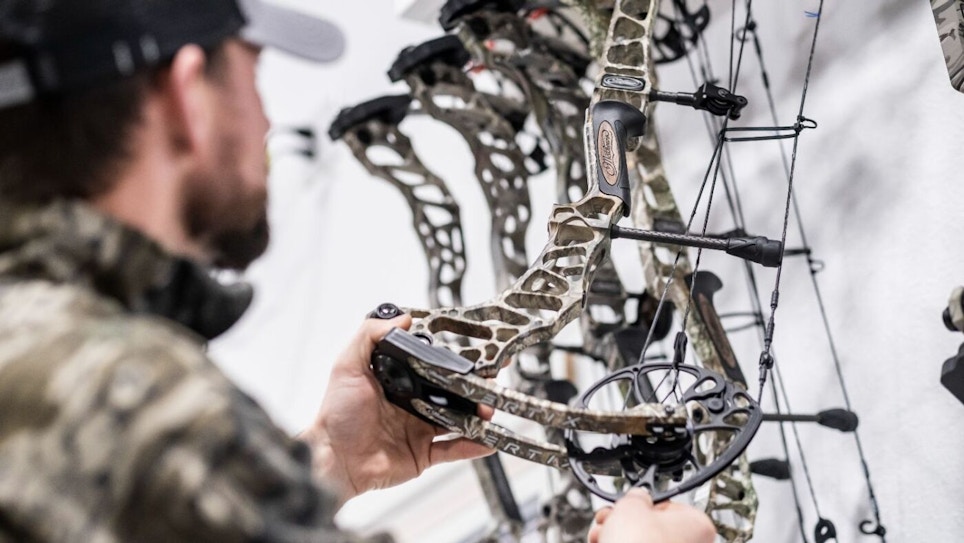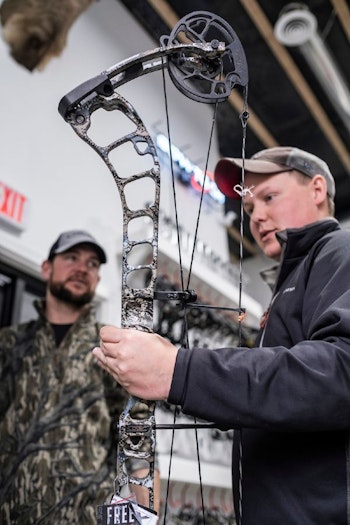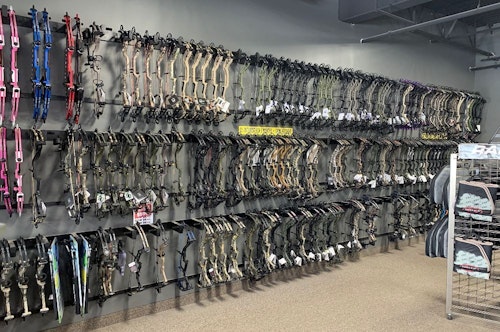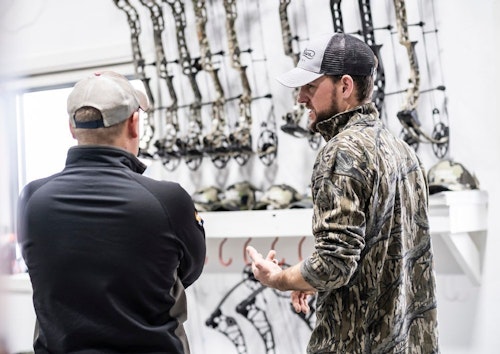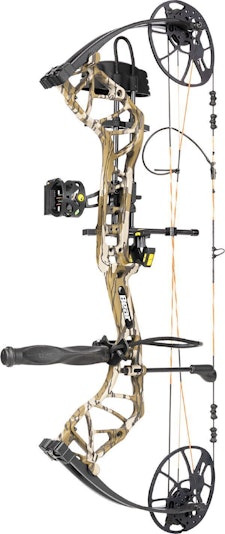Bowhunters are killing more whitetails annually than they have in recorded history. Each year, more and more hunters take deer than in years before. Archery harvest totals continue to grow, and as they do, archery gear grows in demand as well (sort of—more on that momentarily). But while some compound bows sell in mass, others don’t. So, what goes into the making of a best-selling hunting bow?
Sales-Driving Factors
The things consumers often inquire about most are provided right up front on each manufacturer’s website — the bow specs. Oftentimes, educated consumers can gauge what they’re looking for based on these numbers. But not all understand what they mean, and dealers are tasked with teaching them effectively.
Axle-to-axle length is important for several reasons, but especially for accuracy. Compounds with longer lengths are better equipped to handle torque and are usually easier to balance. Longer bows are more forgiving and therefore more accurate; it’s why competition target bows are longer than most hunting bows. Shorter bows are better for confined spaces, such as low-level stalking and ground blinds.
Brace height, which is the distance between the bow string and the deepest point of the bow grip, is another selection that’s important to consumers. Generally, longer brace heights are slower bows, but are also easier to shoot. Conversely, shorter brace heights make faster-shooting bows, but are more difficult to control.
Speaking of speed, hunters oftentimes want more of it. The faster a bow, the less time a deer has to jump the string. That said, a deer can jump the string from the fastest compounds on the planet, and even crossbows shooting 500 fps. It is true that a fast bow is more forgiving of range estimation errors because its arrow travels on a flatter trajectory.
Draw length is another big one. If the bow doesn’t fit the shooters draw length, it isn’t going to work. Generally, adult bows offer approximate 5-inch ranges. Draw weight is similar. Generally, these come in 10- to 15-pound ranges, and hunters must be fitted to the weight that works for them. Along those lines, holding weight varies from bow to bow, too. And with modern compounds, the let-off percentage typically lands somewhere between 80% and 90%.
Physical weight is a crucial matter, and one of the primary talking points for customers. “Nowadays, they try to make everything lighter, especially with these carbon bows,” said Logan Beach, archery tech for Mammoth Outdoors in Bowling Green, Kentucky. “For the past year or two, when someone picks one up, the first thing they says is how heavy or light it is. After all, that’s the first impression.”
That said, lighter isn’t always better. While lighter bows are easier to tote over longer distances, they’re also more difficult to hold steady at full draw, especially with higher wind speeds.
Nocking point and center shot also matter to consumers. As does accessory compatibility. With a rapidly changing accessory industry, this is more important than ever before. Some companies are making it easier to fit their rigs with more accessories, while others are making it more difficult and exclusive.
Naturally, how well the bow fits and feels when test shooting is a big factor in bow selection. Draw cycle is mostly impacted by cam design, and directly relates to what archers refer to as the valley and backwall. Oftentimes, shooters prefer a shallower valley, but others like a deeper valley. Again, it all points back to individualized preferences. Additionally, balance, noise, vibration, accuracy, forgiveness and tunability factor in, too.
Lastly, affordability is one of the first things archers consider. The price tag matters. Even if a bow shoots and feels great, the tag might be too much to stomach. As inflation soars, this factor will, too.
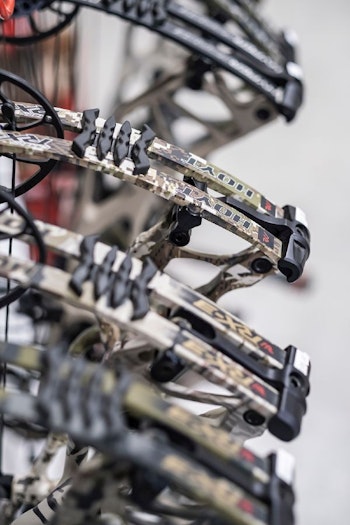
Competition Between Brands
Obviously, every bow company in the market is trying to address each of the above compound archery elements. Generally, there are minor differences between brands, and many of them license the same technologies to put into their bows. It’s the specialized looks and nuances that make them different.
Certain features and specs have more impact on whether a bow sells or doesn’t sell, though. It can look and shoot great, and still not leave the shop bow rack. Why is that? Certain checkboxes are more important than others to consumers, including overall weight, draw cycle, and more.
“How stiff it is up front, or how aggressive it is in the back wall, certainly matters,” Beach said. According to him, this year, two or three bows frequently receive commentary on how different, and even undesirable the backwalls are feeling.
While some note feel as most important, others rank adjustability and fit slightly ahead of that. Larry McCoy, media director for Elite and other brands from The Outdoor Group, says the biggest factor is how well a bow can be tuned to an individual.
“We coined the term shoot-ability,” McCoy said. “The definition of it is determined by the customer. Our bows are so customizable. Everyone shoots differently. When a guy steps into a batter’s box, there are great mechanics, but everyone’s stance is different. That’s just how they’re comfortable doing it. So, what really resonates with the Elite customer is them getting a bow and it feeling exactly the way they want it to.”
This year, Elite achieved that with a very customizable cam system, very smooth draw, dialing in draw weight, setting holding weight, choice of limb stop vs. cable stop, and being able to adjust draw length with quarter-inch increments. According to McCoy, these micro adjustments are much more effective in setting up a shooter for success.
In the flagship category, the Elite Era offers great adjustability. According to Elite, the Era is one of its best-selling bows ever. “This was a 3-year venture of developing and testing,” McCoy said. “We would not come to market with a carbon bow without having all the features Elite is known for. We developed a top-of-the-line bow on a carbon platform with the new SET technology for ease of tuning, along with maintaining the smooth draw cycle, and having the capability to customize the fit and feel to the shooter’s wants and needs.”
Similarly, an example of a very adjustable budget bow is the Bear Legit. It’s crafted to fit all ages and skill levels. With a 14- to 30-inch draw length, 10- to 70-pound draw weight, and virtually all adjustments being made using an Allen wrench with no need for a bow press, it’s incredibly adaptable. It even comes equipped with Trophy Ridge accessories, including a four-pin sight, quiver, Whisker Biscuit rest, peep sight and D loop. It weighs only 3.6 lbs. and shoots 315 feet per second.
“There are a lot of great bows on the market, but the customer keeps a bow company alive,” McCoy said. “A good customer experience, responses from customers, actually listening to them and the things they are looking for, and putting that into a bow, is the biggest part of success.”
Competition Within a Brand
According to some sources, the ratio of flagship-to-budget bow sales is changing. While it was once skewed more toward flagship models, that’s shifting. There are two reasons for this. First, machined riser aluminum bows are miles ahead of where they once were. But more importantly, prices are getting out of control and continue to escalate at a rapid pace. Many of the “budget bows” are selling at yesteryear flagship prices. To that point, are archery shops beginning to see customers pull off flagship bows due to increasing price tags? Are price-point bows eating up a larger percentage of the market now?
“You still have about 35-40% of guys buy flagship bows no matter what the tag says,” Beach said. “But most of those guys are buying the same brand every year. Still, the price point stuff is getting better. Right now, the Hoyt Torrex is a big one. It’s an $850 bow and you get everything but a release and arrows with it. That includes a drop-away rest, five-pin sight, and a detachable quiver. A lot of guys are seeing the $1,300-$1700 price tags next to the Torrex and saying ‘no’ because they can get everything under $1,000.”
On this matter, the new hunting bow price record was recently broken by Xpedition. The 2023 XLite 33 just launched, but it takes a hefty $1,999.99 to take it home. Grant it, this bow is made with the proprietary alloy Magnite material, which Xpedition says is strong and more consistently manufactured than carbon and lighter than aluminum. Still, that’s a stack of cash.
Out of curiosity, I asked 10 diehard bowhunters about it who routinely upgrade bow models. Call it a virtual roundtable focus group, if you will. The majority agreed that this price, along with some other models, is too high. We’ll soon find out if hunters are willing to pay two grand for a hunting bow, though.
Does Marketing Still Matter?
Of course, it does. The archery business is largely driven by independent and big-box retailers. For most bow brands, a very small percentage of bow sales are driven by direct-to-consumer means, if at all. So, as with any industry, some companies do a better job of marketing their products and increasing demand for their offerings.
Naturally, most brands still implement a wide spectrum of marketing tools, including professional tournament archery pro staff results, hunting pro staff, print ads, digital ads, television sponsorships, digital sponsorships, social media influencers, native advertising and more.
“I think the professional and television personalities matter a lot less than they used to,” Beach said. “With social media, it seems companies have five times the staff representing their stuff.
Today, digital media is a massive driver of sales. A lot of the television personalities didn’t make the transition to social media, or even the internet. Of course, that’s no secret. Still, some bow companies recognize that better than others. Beach, and other pro shops, say that many incoming customers are seeing product on digital outlets, such as Instagram, Facebook or YouTube. And now, even TikTok.
Furthermore, the best manufacturing marketing departments work with dealers to inform them on their offerings. They also teach dealers the best way to fit customers with the right bows. After all, bows are like shoes: everyone needs a slightly different fit and feel.
The Truest of Truths
Today, very seldom do bow manufacturers release lemons. While the same couldn’t be said for the 2000s, and even early to mid-2010s, very few “bad” bows hit the market in the last 7 or 8 years. Truth be told, each bow company is good at what they do, and that’s why the market is so tight today.
Sure, market share is still dominated by certain players, but their margins aren’t what they once were. This is true for almost all niche-specific companies in the hunting industry. As the entire market continues to mature, in most market sectors, market share will gradually decline. Unless a company, or group of companies, hit product or marketing home runs, that trend will likely continue.
That said, as ingenuity and bow tech novelty slows, product home runs (at least differentially) will become less likely. Eventually, due to increased competition, companies will likely begin dropping prices. That is, unless rapid inflation continues.
Two things Beach reports are requested far more than they were even just a few years ago? Layaway and warranty. This change signals that buyers are thinking longer term when they make a purchase.
“Guys who aren’t diehard or out there all the time, if they do buy a new bow, it’s going to be with them 5-plus years,” he said. “So, the warranty, and customer service, are important.”
This begs the question — is it necessary to buy that new bow, year after year? While modern bows are more durable, and holding value better than ever before, only the consumer can decide that.
Overall, while many things change, the fundamentals of business do not. Companies that address challenges effectively, remain in tune with consumer needs, build bows consumers want, price accordingly, market wisely, and that have teams of professionals all rowing in one direction, will be the bow maker winners of tomorrow. They will make the best-selling hunting bows.
Sidebar: Youth Bow Considerations
Adjustability, including draw length and draw weight, are the driving factor with youth bow sales. And that’s why companies have adapted to offer what the consumers demand — long-lasting youth bows that can grow with the archers themselves.
“Kids grow every day,” Beach said. “They don’t want to buy new bows constantly. Ten to 15 years ago, you’d at least have to take the module out of it every year. Now, you can buy something that goes from 17- to 30-inch draw length and 15-70 pounds, so they can grow with it. Some of these youth bows are $800-$1,000. Still, you can get some for $500.”
Sidebar: No More Annual Releases?
Throughout the years, the archery landscape changed in spurts. From its inception to modern day, many companies played roles in that. In fact, while some contributed more than others, virtually all of them had a hand in it. Bear, Bowtech, Darton, Elite, Hoyt, Martin, Mathews, Pearson, PSE, and all the rest, have done their part in advancing the technology.
Take the Bowtech Destroyer 340 and 350, for example. “These redefined compound bow performance in 2010,” said Bowtech Brand Manager Todd Snader. “The world was introduced to the revolutionary OverDrive Binary Cam System with tunability like no other. This groundbreaking bow was another leap in the evolution of archery.”
However, Beach, along with many other professionals, believe bow companies are running out of new concepts and technologies to implement. “It depends on the company, but several in the past year or two offered new components with the same riser and cam as it was the year before,” he said. “Really, that’s happened some for the past 5 years.”
Interestingly, while the used bow market wasn’t as popular, it’s becoming more so each year. When companies were pumping multiple new bows out year after year, the value of that bow was losing 50% value just outside the shop door. Now that companies are pushing the same bows for multiple years, that trend is reversing. For example, the older Hoyt RX bows are holding value better compared to the new Hoyt RX-7, which hasn’t changed much.
“It’s changed a lot more in the last 5 years than the previous 10,” Beach said. “That said, things are coming to a head. You’re going to see companies making bows every 2 years, instead of every year. That trend already started. New offerings are going to be more accessory based.”
Overall, this shift is a result of lacking new ideas and supply chain issues. Ripple effects are still being felt from the Covid-induced material shortages. Initially, some companies produced less than half of their typical annual output. Backorders and other issues have gradually improved the past few years, but some issues remain, especially material sourcing.
For all these reasons, bow companies are turning more to accessories to ramp up revenue. Will this hurt third-party archery accessory companies? Perhaps so, but honestly, it’s amazing bow manufacturers didn’t heavily target this sector of the archery market decades ago.
